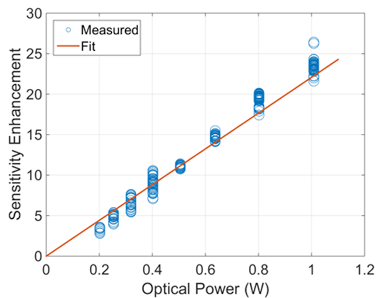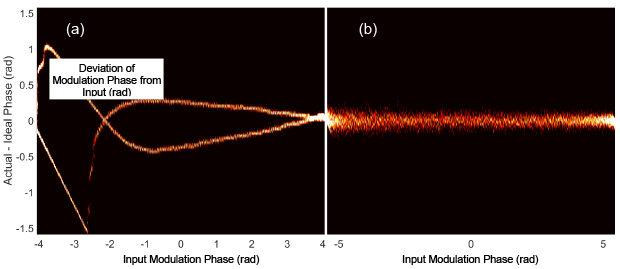Peter Devore (15-FS-011)
Abstract
Certain important diagnostic and communication applications receive faint electrical signals that must be transmitted over long distances for capture. Optical links reduce bandwidth and distance restrictions of metal transmission lines. However, such signals are only weakly imprinted onto the optical carrier, resulting in low fidelity transmission. Increasing signal fidelity often necessitates insertion of radio-frequency amplifiers before the electro-optic modulator, but (especially at high frequencies) such amplification results in large irreversible distortions. We have investigated the feasibility of a sensitive and linear modulation by optical nonlinearity (SALMON) modulator to supersede radio-frequency-amplified modulators. SALMON uses cross-phase modulation to enhance the modulation depth of an radio-frequency-modulated optical wave. This ultrafast process has the potential to result in less irreversible distortions as compared to a radio-frequency-amplified modulator. Using the SALMON modulator, we demonstrated a sensitivity enhancement factor greater than 20 and significantly reduced distortion, proving it a feasible alternative to a radio-frequency-amplified modulator.
Background and Research Objectives
Many diagnostic and communication systems, such as cellular telephone networks and radar, receive weak signals that must be amplified and remotely sent over long distances to receivers. Although optical links alleviate the bandwidth and distance restrictions of metal wires for transmission to receivers, weak signals are unable to fully modulate an optical wave, resulting in poor dynamic range. Radio-frequency amplifiers are commonly employed before electro-optic modulators. The resultant radio-frequency-amplified modulators increase modulation for fiber optic delivery but severely degrade fidelity.
We investigated the feasibility of a SALMON modulator to supersede radio-frequency-amplified modulators. SALMON uses the Kerr effect, which is a change in a material’s refraction in response to an applied optical field, to increase modulation depth in the optical domain with less irreversible distortion than use of a radio-frequency amplifier in the electrical domain. The prototypical SALMON modulator uses the cross-phase modulation aspect of the Kerr effect to perform modulation depth enhancement. In cross-phase modulation, one wavelength of light can affect the phase of another wavelength, proportional to the first wavelength’s instantaneous power. This has the potential to enhance the modulation depth of a pre-existing modulator by exploiting the multiplicative power dependence of cross-phase modulation. In addition, because cross-phase modulation is an ultrafast process, the modulation frequency dependence should be drastically reduced, resulting in less irreversible distortions in a SALMON modulator as compared to a radio-frequency-amplified modulator. Our goal was to address (1) how much sensitivity enhancement could be achieved, (2) the feasibility that a SALMON modulator can result in less-irreversible distortion, and (3) the noise and distortion impact.
Scientific Approach and Accomplishments
We found that the SALMON modulator can achieve sensitivity enhancements greater than 20 times while exhibiting less irreversible distortion, and we also investigated its impact on noise. For this study, we experimentally quantified the sensitivity enhancement, distortion, and noise of a conventional modulator and our SALMON modulator with an experimental test bed. We also created a physics-based end-to-end model to evaluate and optimize experiments.
For our modeling effort, we calculated the relationship between voltage into an electro-optic modulator and voltage out of the photodetector for a general optical link.1 When an electro-optic modulator is fed by a carrier laser and input radio-frequency voltage VRF,in and subsequently identified with the photodetector, the output voltage VRF,out is related to system parameters by
VRF,out = VRF,in(πPcar RLResp / (4Vπ)) (Equation 1)
where Pcar is the carrier laser power, RLis the photodetector load resistance, Resp is the photodetector responsiveness, and Vπ is the half-wave voltage of the electro-optic modulator. There are practical limits to the values of the quantities in the parentheses, so a larger output voltage necessitates amplifying the input in the radio-frequency domain, resulting in the aforementioned distortion and fidelity reduction.
By contrast, in the SALMON modulator, the bare electro-optic modulator is instead fed by a pump laser, which is followed by a cross-phase modulation stage. In this stage, a carrier laser undergoes cross-phase modulation by the modulated pump laser, which imparts the pump laser modulation onto the carrier laser. Finally, the now-modulated carrier laser is identified by the photodetector. As a result of this study, and using nonlinear optical theory,2 we derived
VRF,out = VRF,in(2PpumpγLK)(πPcar RLResp / (4Vπ)) (Equation 2)
where Ppump is the pump laser power into the cross-phase modulation stage, γ is the cross-phase modulation stage nonlinear factor, L is the cross-phase modulation stage length, and K, which is a factor near to but less than 1, depends on the pump and carrier polarizations and propagation loss in the cross-phase modulation stage. We see from Equation 2 that the gain in output voltage is simply given by the modulation depth enhancement or sensitivity enhancement factor X = 2PpumpγLK. This quantity can practically be large (X >10), resulting in net gain. In addition, this gain factor is linearly proportional to the pump, which shows the ability to increase the modulation depth using purely optical means, with the potential to avoid the use of a radio-frequency amplifier and its concomitant degradation of fidelity.
It is important to note that in Mach–Zehnder modulators (commonly used for controlling the amplitude of an optical wave), the input voltage results in a modulator phase, and at the end of the link results in a detected voltage. Any increase in the modulator phase results in a larger voltage identified with a photodetector. Examining the phase alone allows one to isolate the electro-optic modulator’s properties independent of the rest of the optical link (e.g., the photodetector and carrier laser).
We measured the strength of the sensitivity enhancement factor as a function of optical power of this SALMON modulator, which uses a highly nonlinear fiber as the cross-phase modulation stage (see Figure 1). Sensitivity enhancement was calculated by measuring the modulation depth with and without the cross-phase modulation stage. The model we created predicts a linear relationship between sensitivity enhancement and pump laser power. Our cross-phase modulation stage was a telecommunications wavelength (1.5-μm) highly nonlinear fiber (Sumitomo Electric), a silica optical fiber whose specialty is to strongly confine the optical field to increase the nonlinearity, and as a result has a nonlinear coefficient γ = 30 x 10-3/W⋅m and length L = 103m. Given the fit in Figure 1 of X = (22/W)Ppump, this implies K = 0.37. The deviation of K from 1 is likely due to a drop in the cross-phase modulation strength from ideality because of walk-off of the relative polarizations of the pump and carrier waves throughout the highly nonlinear fiber, pump loss along the fiber, and pump-carrier group velocity dispersion. Experiment-to-experiment differences in sensitivity enhancement factor could be caused by pump and signal polarization drift over time due to environmental fluctuations. The great agreement between theory and experiment lends strong credence to the origin of the observations, and also shows the ability to engineer the amplification strength.
Figure 1. Sensitivity enhancement factor versus peak optical power into a highly nonlinear optic fiber. Here, we see the expected linear relationship between the two as predicted by our theory. Fit is sensitivity enhancement factor X = (22/W)Ppump.
We also quantified the noise and distortion introduced by radio-frequency amplification and cross-phase modulation. Figure 2 shows the distribution of amplified modulator phase errors (deviation of modulation phase from input) as a function of the input modulation phase, so more deviation from no error (a thin, horizontal line at 0) indicates worse performance. In a radio-frequency-amplified modulator, even use of a high-performance, radio-frequency amplifier (PhotLine, model: DR-AN-20-HO) results in large distortion, as evidenced by the large hysteresis loops shown in Figure 2(a). In contrast, for the SALMON modulator, no distortion is discernible. In the cases highlighted here, the SALMON modulator is amplifying a higher radio frequency (1.5 vs. 0.8 GHz), more radio-frequency power (5 dBm vs. -1 dBm), and at a higher sensitivity enhancement factor (25.5 vs. 22.9), than the radio-frequency-amplified modulator. One would expect all three of these factors to increase distortion if the cross-phase modulation stage were replaced by an equivalent radio-frequency amplifier. However, because we find even less distortion, the SALMON modulator is unequivocally much more linear than the radio-frequency-amplified modulator. This first demonstration resulted in an increased noise floor, indicating that more work is needed to determine the source of this noise floor and mitigate it.
Through this work, the Laboratory gained a unique modulator technology for high-fidelity capture of weak signals. In addition, this addresses a pressing need for the Department of Defense's Defense Advanced Research Projects Agency: higher sensitivity for radar applications. Electronic warfare requires the best performance possible. However, weak signals are often lost in a sea of noise, as well as jamming signals and their distortions. The SALMON modulator has the potential to provide the increase in sensitivity necessary for these applications.
Impact on Mission
Many high-speed temporal diagnostics of advanced fusion-class lasers, laser target-chamber dynamics, and weapons tests require detection of weak radio-frequency signals that must be sent over long distances to protect valuable hardware from damage. A new electro-optic modulator technology for delivery of these signals would enable both high sensitivity and fidelity in support of the Laboratory’s core competencies in lasers and optical materials science and technology and high-energy-density science.
Conclusion
We determined that the SALMON modulator has passed the test of feasibility—that is, it exhibited sensitivity enhancement greater than 10 (actually >20) and had significantly lower distortions than a state-of-the-art radio-frequency amplifier. These results are very promising for the future deployment of this class of modulators in an array of applications. However, this study also raised a question about its noise performance. Although the SALMON modulator clearly outperformed a high-performance radio-frequency-amplified modulator, its performance could potentially be significantly improved. Further work is needed to ascertain the source of the additional noise in this modulator to determine whether the noise can be mitigated. In addition, there is a very large and rich parameter area to explore to further optimize the performance of SALMON modulators, including, but not limited to, choice of optical wavelength and highly nonlinear fiber (which influences nonlinearity and dispersion).
References
- Chang, W. S. C., RF photonic technology in optical fiber links. Cambridge University Press, Cambridge, U.K. (2002).
- Agrawal, G. P., Nonlinear fiber optics. Elsevier, Burlington, MA (2007).







